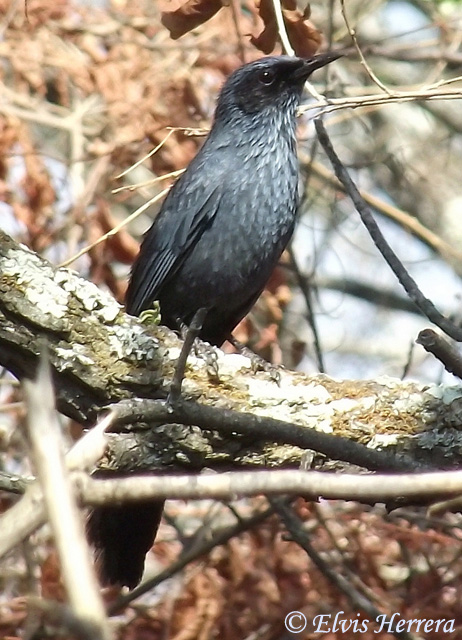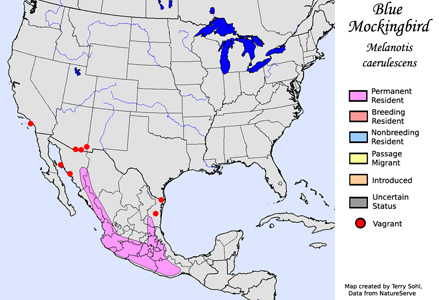| Length: 10-11 inches | Wingspan: 13-14 inches | Seasonality: Non-resident in South Dakota |
| ID Keys: Blue color overall, but color varies depending upon sun angle, from bright blue, to gray, to almost black. Dark facial mask. | ||
 The
Blue Mockingbird has a normal range that covers much of Mexico, but in the
United States, they are just rare vagrants. The majority of sightings
have occurred in southeastern Arizona or southwestern New Mexico, but there
also have been sightings in southern California and Texas. The Blue
Mockingbird is a commonly sold cage species in Mexico, and there is some
thought that some sightings in the U.S. are not of wild origin, but are of
captive escapees. However, the natural range of the species does
extend to within 150 miles of Texas and Arizona, and it is likely that at
least some of the sightings in the U.S. are of naturally dispersing wild
birds.
The
Blue Mockingbird has a normal range that covers much of Mexico, but in the
United States, they are just rare vagrants. The majority of sightings
have occurred in southeastern Arizona or southwestern New Mexico, but there
also have been sightings in southern California and Texas. The Blue
Mockingbird is a commonly sold cage species in Mexico, and there is some
thought that some sightings in the U.S. are not of wild origin, but are of
captive escapees. However, the natural range of the species does
extend to within 150 miles of Texas and Arizona, and it is likely that at
least some of the sightings in the U.S. are of naturally dispersing wild
birds.
Habitat: Found in shrubby habitat and thick undergrowth of woodlands. In Mexico, they can be found from near sea level to as high as 10,000 feet in the mountains, although there is an elevational migration between the breeding and non-breeding season. They can be found in arid, shrubby areas as well, but typically only near sources of water, such as along shrubby riparian areas.
Diet: Feeds on insects, spiders, fruits and berries. The female usually lays 2 blue eggs.
Behavior: Often found in thick vegetation and can be difficult to observe. Typically found in the lower levels of vegetation, or on the ground. Becomes much more easy to observe when vocalizing, as they may choose a more prominent perch.
Nesting: Nest is a cup built of twigs, roots, and other vegetation.
Song: The song of a Blue Mockingbird is a series of complex, melodic phrases with occasional harsher notes interspersed.
Migration: Considered permanent residents throughout their normal range, but Blue Mockingbirds do make short-distance, elevational migrations between breeding and non-breeding season.
Interactive eBird Map: Click to access an interactive eBird map of Blue Mockingbird sightings
Feeders: May visit feeders for fruits
Similar Species: Not likely to be confused with another species in North America, if seen well.
Conservation Status: Populations may be declining, but they are still found over a relatively wide geographic region and are common in some locations. The IUCN lists the Blue Mockingbird as a species of "Least Concern".
Further Information: 1) Audubon Guide - Blue Mockingbird
2) Whatbird - Blue Mockingbird
3) Arizona Field Ornithologists - Blue Mockingbird
Photo Information: Photo taken by Elvis Herrera - June 5th, 2011 - Lomas del Punhuato, Morelia, MI, Mexico - Photo licensed under Creative Commons Attribution NonCommercial ShareAlike 2.0 Generic License.
| Click below for a higher-resolution map |
 |
| South Dakota Status: Non-resident in South Dakota |
Additional Blue Mockingbird Photos (coming soon!!)
